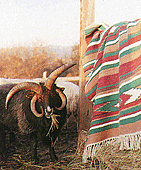
Side Trip: Tierra Wools, Los Ojos, New Mexico USA98 miles west of Taos is an enterprising center |
Los Ojos, New Mexico is a place where dreams are pursued, and often fulfilled . . . through incredibly hard work, courage, tenacity and a healthy measure of personal brilliance. To this valley of the Chama River, Spanish-speaking people came seeking pasture for their sheep nearly 200 years ago. They lived off the land, surviving harsh mountain isolation through cooperation and self reliance. These values created and nurture Tierra Wools, one of the programs of Ganados del Valle (Livestock Growers of the Valley, or, stated more romantically, Flocks of the Valley). The history of Ganados is populated with people whose individualism, vision and stubborn determination have created a thriving collective enterprise. The ideas of three of those people, Gumercindo Salazar, Maria Varela and Antonio Manzanares, solidified into a nonprofit corporation that raises sheep for wool and food, employs local women to weave clothing and rugs from the wool, and sells the arts and crafts of the valley's artisans. |
A churro sheep and an example of handwoven work from its wool |
Their goal in the early 1980s was a homegrown business that would use local resources rather than outside investment and development. And of greatest importance would be the preservation of the region's cultural identity. The success of that vision is exemplified in the four businesses of Ganados: Pastores Lamb, a direct marketing association; Pastores Feed & General Store, a showcase for early New Mexican frontier arts and crafts; Rio Arriba Wool Washing; and Tierra Wools, a spinning and weaving cooperative . . . and, of course, in the churro sheep. The churro were the sheep brought to the valley by the Spanish in the 1500s, and they later became known as the Navajo churro. And by the 1970s they were nearly extinct. Mixed-blood remnants of churro sheep were discovered in the Ganados flocks, and through collaboration with Lyle McNeal, a Utah State University professor, a cooperative breeding program was instituted. Today, Ganados del Valle works to save the old Spanish Churro sheep line from extinction and is also introducing other unusual wool breeds to the valley. The churros produce a very desirable, low grease wool that is longer staple than Merino or Rambouillet wool, keeps its natural colors longer and takes a dye very well. Having plucked the churro from near-extinction, the common aim of Ganados is to ensure that wool growing, shepherding and weaving continue as a way of life in the Chama Valley. Tierra Wools offers a glimpse of the past . . . back to a time when the Hispanic weaving tradition maintained village artisans through long cold winters. Then, the Rio Grande weaver quenched a deep thirst for color, harmony and spirituality by weaving for family, church and community. In the early 1980s, the fledgling Ganados organization needed to train the local women in the ways of commercialism without invading the spirit of their history. To that end, professional weaver Rachel Brown of Taos was engaged. She introduced the spinning wheel to women who traditionally had used a hand spindle to spin yarn; she gave lessons at the old convent in Los Ojos and helped open the store that would sell the coats, blankets, pillow and other products that they made. Today, Tierra Wools, a cooperative self-supporting enterprise, conserves the best of the Hispanic weaving tradition. The hand-dyed colors in the yarns are created in outdoor dye pots over pinon and cedar fires. The Tierra Wools weavers draw inspiration from design elements in old Rio Grande blankets to create entirely original, one-of-a-kind works of art. This is a unique and totally integrated wool growing and weaving enterprise. Most importantly, the living tradition of the weavers is perpetuated through their teaching of the art of spinning and weaving to the children of the valley. The Tierra Wools Showroom and taller (workshop) is in a century-old mercantile building located in the village of Los Ojos. The public is invited to see weavers, spinners and dyers at work as well as to browse through a large selection of colorful handwoven creations. For many, the "bottom line" is that Ganados del Valle provides jobs in a poor community, that it has renewed self-esteem and that it has brought economic power to people in the valley. The people who developed the small businesses that have grown out of Ganados del Valle are, for the most part, self-taught . . . pride in their community's accomplishments is well-earned. Deep-rooted culture and history are integral parts of the Chama River valley's economic development . . . and will play an important part in the community's survival. |
|
Thanks to the folks at
Originally appeared in |
Related Pages |
|
|
Hispanic Arts and Crafts Tour of Northern NM |
Traditional New Mexican Hispanic Crafts |
|
Visit the Calendar of Events Search Page for complete exhibit and performance information. LAST MODIFIED September 25, 2007 |
